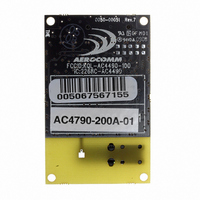AC4790-200A-485 Laird Technologies, AC4790-200A-485 Datasheet - Page 12

AC4790-200A-485
Manufacturer Part Number
AC4790-200A-485
Description
TXRX 900MHZ 3.3-5.5V FHSS 200MW
Manufacturer
Laird Technologies
Series
AeroCommr
Specifications of AC4790-200A-485
Frequency
902MHz ~ 928MHz
Data Rate - Maximum
115.2kbps
Modulation Or Protocol
FHSS, FSK
Applications
AMR, Fire & Security Alarms, Telemetry
Power - Output
5mW ~ 200mW
Sensitivity
-110dBm
Voltage - Supply
3.3V, 5V
Current - Transmitting
68mA
Data Interface
Connector, 2 x 10 Header
Antenna Connector
On-Board, Chip
Operating Temperature
-40°C ~ 85°C
Package / Case
Module
Wireless Frequency
900 MHz
Interface Type
20-pin mini connector
Board Size
49 mm x 42 mm x 5 mm
Modulation
FHSS, FSK
Security
1 byte System ID, DES
Operating Voltage
3.3 V to 5.5 V
Output Power
200 mW
Antenna
Integral and External Dipole
Lead Free Status / RoHS Status
Contains lead / RoHS non-compliant
Memory Size
-
Current - Receiving
-
Lead Free Status / Rohs Status
Lead free / RoHS Compliant
T
M A S T E R L E S S A R C H I T E C T U R E
The Masterless architecture is a true peer-to-peer architecture, where any module that has data to transmit will initiate
a communication Session with a transceiver(s) within its range, transmit data and exit the Session. This architecture
eliminates the need for a master which dictates data flow control, hence reducing additional system overhead and
greatly improving efficiency.
M O D E S O F O P E R A T I O N
The AC4790 has three different operating modes; Receive, Transmit, & Command Mode. If the transceiver is not
communicating with another radio, it will be in Receive Mode actively listening for a sync pulse from another
transceiver. If the radio determines that it is a broadcast or addressed sync pulse, it will respond by going into session
with the radio. A transceiver will enter Transmit or Command mode when the OEM Host sends data over the serial
interface. The state of the Command/Data pin (Pin 17) or the data contents determine which of the two modes will be
entered.
T r a n s m i t M o d e
All packets sent over the RF are either Addressed or Broadcast packets. Broadcast and Addressed delivery can be
controlled dynamically with the API Control byte and corresponding on-the-fly commands. To prohibit transceivers
from receiving broadcast packets, Unicast only can be enabled.
When sending an addressed packet, the RF packet is sent only to the receiver specified in destination address. To
increase the odds of successful delivery, Transmit retries are utilized. Transparent to the OEM Host, the sending radio
will send the RF packet to the intended receiver. If the receiver receives the packet free of errors, it will return an RF
acknowledge within the same 50 ms hop. If a receive acknowledgement is not received, the radio will use a transmit
retry to resend the packet. The radio will continue sending the packet until either (1) an acknowledgement is received
or (2) all transmit retries have been used. The received packet will only be sent to the OEM Host if and when it is
received free of errors.
When sending a broadcast packet, the RF packet is sent out to every eligible transceiver on the network. To increase
the odds of successful delivery, Broadcast attempts are utilized. Transparent to the OEM Host, the sending radio will
send the RF packet to the intended receiver(s). Unlike transmit retries, all broadcast attempts are used; regardless of
when the RF packet is actually received and without RF acknowledgements. If the packet is received on the first
attempt, the receiver will ignore the remaining broadcast attempts. The received packet will only be sent to the OEM
Host if and when it is received free of errors.
When a radio has data to transmit, it sends out a sync pulse to initiate a session with one or more radios. This 25 ms
sync pulse is sent during the first half of each 50 ms hop and transparent to the OEM Host. Once a Session has been
established, the radio transmits the data during the remaining 25 ms of the current hop. The radio will stay in Transmit
mode until its Session Count expires. When sending addressed packets, Session Count is defined as Session Count
Refresh (EEPROM address 0xC4) + number of transmit retries (EEPROM address 0x4C). When sending broadcast
HEORY OF
A D D R E S S E D P A C K E T S
B R O A D C A S T P A C K E T S
O
PERATION
www.lairdtech.com\wireless
3


















